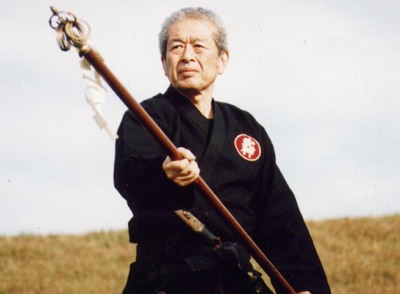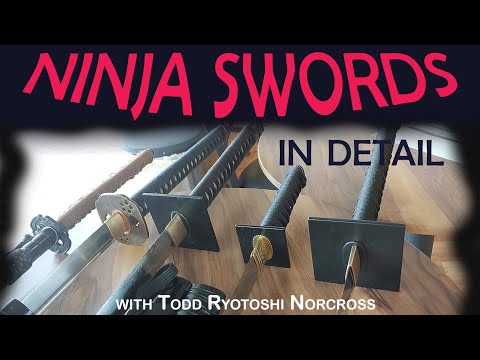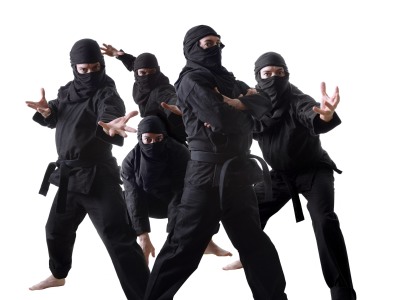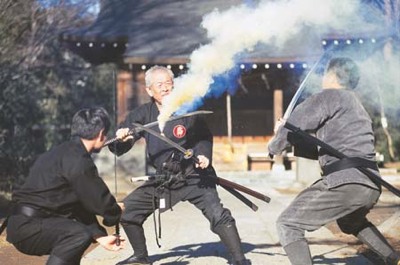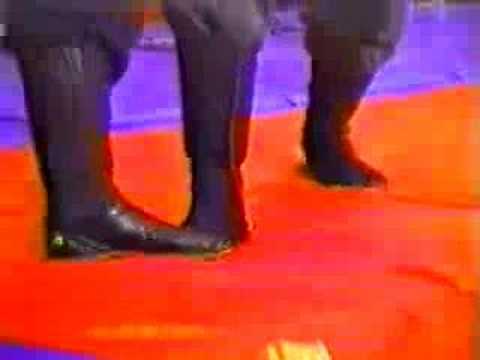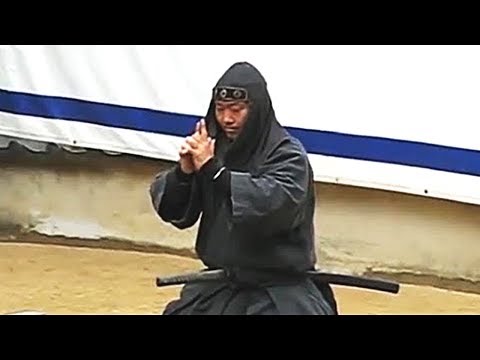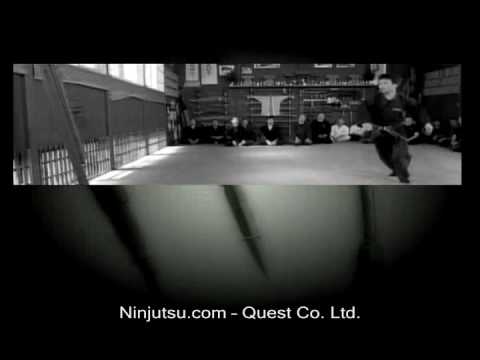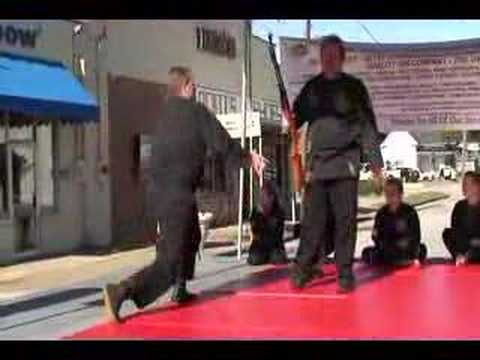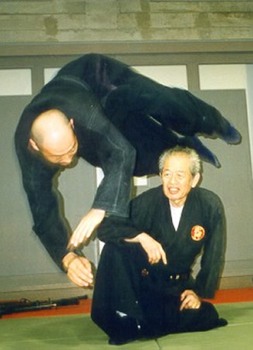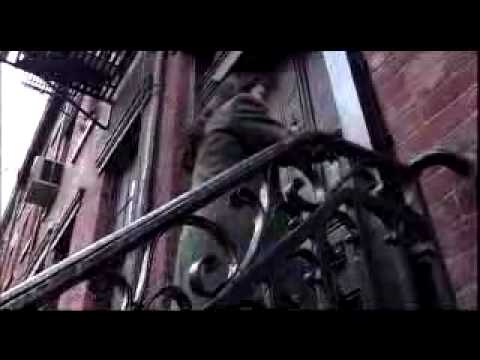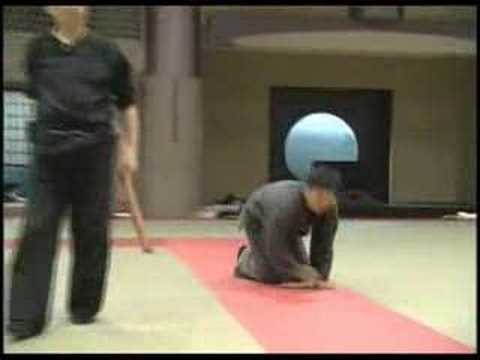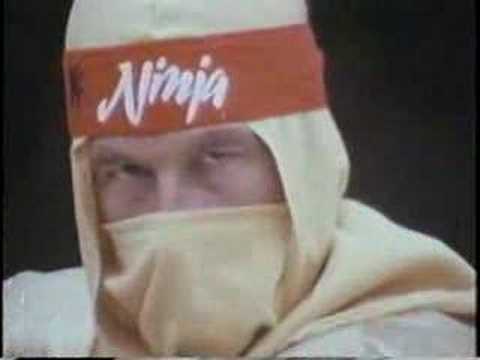Myth: Real ninjas are a myth In fact, ninjas and the arts that they learnt date back to over eight hundred years ago. The ninja families developed their skills in order to protect themselves against the likes of Samurai warriors. It is this humble beginning that gives ninjutsu its very unique style: escape if you can, if you can’t, kill. There was nothing unethical to the ninja – he would throw sand in the enemies eyes, stab them when they were down, anything to protect life and limb. Over time the ninjas were used as spies, bodyguards (right up to the last emperor), and assassins for hire.
Myth: As a matter of course, Ninjas caught swords with their bare hands This is not entirely true – and the video clip above has a particular moment that illustrates why. At 07:38 Grandmaster Hatsumi (current Bujinkan grandmaster who studied under the last true combat Ninja Toshitsugu Takamatsu who served as the bodyguard to the last Chinese Emperor – see the video clip in item 5) demonstrates how to deal with an incoming sword in the greatest Ninja fashion: “Just get out of the way.” If you watch the whole clip you will see that almost every possible sword attack can be deflected (and turned to your advantage) without needing to go near the weapon. Of course in movies it looks flash to have a ninja catch a sword – but there would be very little need to do so when a Ninja has so many other techniques in his arsenal. Having said that, using claws or other hand weapons, if it were necessary, a Ninja might stop a sword with the weapons he is holding – but not with his bare hands.
Myth: Ninjas wore masks when fighting and black clothes; it is their uniform. This is entirely false. These days most ninjas who are working as bodyguards would wear a suit or similar modern clothing. So when might a ninja have worn a mask? Maybe eight hundred years ago if they had to hide in the trees – but even then it was not part of a “uniform”. A ninja wearing a mask is no different to a soldier wearing camouflage paint. It depends entirely on the environment and the need for hiding. This, of course, is true also of black clothing.
Myth: Ninjas were able to vanish This myth has come about because of the first ninja rule: get away. If a ninja can avoid fighting, he will. In order to achieve this goal, he might need to create a diversion of some kind, such as throwing shuriken, setting off a smoke bomb (as in the image above), or throwing sand in the opponent’s eyes. By the time the opponent recovered from the distraction, the ninja would be gone. There is no magic involved here – just commonsense.
Myth: Ninjas can’t kill just by touching I bet you weren’t expecting that! In fact, there are a series of touches (this word is used lightly as a decent amount of pressure is needed) that can render a person dead. This is quite logical when you consider that a firm enough blow to the temple can kill a person. The deadly methods are normally only taught to the most advanced students who, by that time, would never need to use them. Fundamental pressure point techniques, however, are taught from the very beginning and even the most basic student can take a person to the floor with one finger (pressed firmly in the right part of the throat, or in the eyeballs for example). Pressure points cause a lot of pain when pressed in the right way – they are an indispensable tool for the Ninja. Furthermore, simple tools like squeezing nipples can also render an offender defenseless in seconds. In the clip above you can see Grandmaster Hatsumi squeezing his opponents nipple – the look of pain on the guy’s face says it all. You can see this around the 03:40 mark.
Myth: Ninjutsu refers to fighting methods In fact, it means the art of stealth and perseverance – it is about the strategy and tactics of fighting. The actual moves are from a variety of different martial art disciplines. In the most common and most authentic version of Ninjutsu (Bujinkan Bud? Taijutsu), eighteen disciplines form the main basis of training:
- Seishin-teki ky?k? (spiritual refinement) 2. Taijutsu (unarmed combat, using one’s body as the only weapon) 3. Kenjutsu (sword fighting) 4. B?jutsu (stick and staff fighting) 5. Shurikenjutsu (throwing shuriken) 6. S?jutsu (spear fighting) 7. Naginatajutsu (naginata fighting) 8. Kusarigamajutsu (kusarigama fighting) 9. Kayakujutsu (pyrotechnics and explosives) 10. Hens?jutsu (disguise and impersonation) 11. Shinobi-iri (stealth and entering methods) 12. Bajutsu (horsemanship) 13. Sui-ren (water training) 14. B?ryaku (tactic) 15. Ch?h? (espionage) 16. Intonjutsu (escaping and concealment) 17. Tenmon (meteorology) 18. Chi-mon (geography) In the clip above you can see Grandmaster Toshitsugu Takamatsu with a student. This is an important clip as Toshitsugu Takamatsu was the last true combat Ninja and the teacher of the current Bujinkan grandmaster (Masaaki Hatsumi – he is speaking on the clip).
Myth: Shuriken (throwing stars) are used to kill at a distance In fact, shuriken are used as a secondary weapons – either to slash or stab. When they are thrown it is normally to cause a distraction as you can see in the video clip above (around 01:08). Shuriken come in two varieties: Hira-shuriken (the famous ninja star) which were originally household items (such as washers and coins that were used to distract and were not usually sharp), and Bo-shuriken which are straight spikes up to 21cm in length. These were also originally household items (as were most Ninja weapons) such as chopsticks or hairpins. Their origins certainly makes it clear that these were not intended as killing weapons. Myth: Ninjas only use ancient Japanese weapons Yes – they do, but not exclusively. Ninjas are often trained in modern weaponry as well – and many of the so-called “ancient” weapons are not ancient at all – they are modern takes on ancient concepts (such as the shuriken whose origins lie in coins as mentioned above). Also note in the list of disciplines above “Kayakujutsu” – this is the art of gunpowder. Ninjas have long used gunpowder to their advantage – either to create smoke screens, or even bombs. In the video clip above you can see Ninjutsu skills applied to gun disarmament. Notice how each movement is not just to remove the weapon, but to use it against the assailant in often unorthodox ways.
Myth: Ninjas need to be strong and fast In fact, the whole point of ninjutsu is to use your body effectively – whether you are fat or thin short or tall. You don’t need speed – in fact speed can work against you. What you need is the ability to predict your opponents move and outthink him. By calm and steady movements you gain control of the enemy and ultimately the fight. In all of the video clips here you can see how slowly Soke Hatsumi moves – granted a lot of it is to demonstrate the move, but notice how his less qualified opponents move faster than he does and he ends up taking them down simply by lightly gripping a part of their body and walking. Much of Ninjutsu is about foot movement and natural positioning. It is this which allows the ninja to retain his balance in all manner of unusual situations. In the image above, we see Hatsumi in a very relaxed position within milliseconds of having thrown his opponent (the guy flying over his head). Myth: Pirates are better than ninjas This long-raging Internet debate is just silly – there is no doubt at all that ninjas are far better and pirates just utterly suck in comparison. There has never been a recorded case of a pirate beating a ninja. Pirates have a cutlass and hook hand but little else to fight with – plus lots of lace and fancy clothes; whereas a ninja has a whole slew of weapons and light-weight clothes which give him an advantage before they even begin. Furthermore, if the pirate looks like he might be winning – the ninja can just jump off the ship and run on water to the nearest island. So – how do you know when you are a good ninja? There is a test used around the 5th Dan level (these levels are not really for anything more than rating how well you are doing – it certainly means nothing in the world world where ability to survive matters most) – this test is called the sakki test. In it, the teacher stands behind the student with a sword (usually made of wood in these tests) above his head. He brings the sword down and (hopefully) the student will “feel” the intention and move out of the way. This can be very embarrassing if you are not read as you end up with a hell of a whack on your head. In the video clip above we see students who are definitely ready for the test. Once you have watched that, check this one out to see some very uncomfortable fails. Ouch. Can you tell I love this stuff? This is a video clip from an eighties movie called “Power of Ninjutsu”. I have included it to show you why Ninjas have a bad name and where some of the ridiculous myths have come from. Line of note: “Ninja… I am a ninja too!” If you have enjoyed the video clips here, I guarantee you will love the huge selection of Ninja DVDs at Budo Videos – seriously, they have thousands. Read More: Facebook Instagram Email
